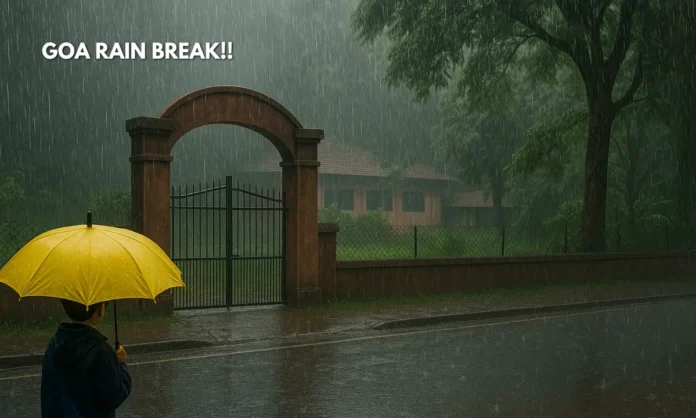- Goa government declares statewide school holiday on July 5 due to IMD’s orange alert for heavy to extremely heavy rainfall.
- Education department urges children to stay indoors, warns against venturing into flooded or riverside areas.
- IMD issues yellow alert for July 5–9; monsoon intensifies across Konkan region, triggering safety and infrastructure concerns.
Monsoon Lockdown: Why Goa Closed Its Schools as Rains Turn Relentless
In a rare but necessary move, the Goa government on Thursday declared a statewide school holiday for Friday, July 5, following the India Meteorological Department’s (IMD) orange alert predicting heavy to extremely heavy rain across the coastal state. The circular, issued by State Education Director Shailesh Zingde, stressed the need to prioritise student safety as showers continued to drench the state for the third consecutive day.
The decision affects all primary, middle, and higher secondary schools, across public and private institutions. While students and most teachers have been granted leave, educators attending training sessions have been asked to report as scheduled.
The announcement comes as Goa experiences intensifying monsoon conditions, with urban flooding, waterlogging, and transport disruption reported in low-lying areas. As the IMD tracks cyclonic circulation over the Arabian Sea and heightened rainfall across the Konkan belt, state authorities are bracing for more than just wet shoes—they are preparing for monsoon-linked emergencies.
VIDEO | The India Meteorological Department has issued an Orange alert for heavy rainfall in Goa on Friday and Saturday, followed by a Yellow alert until July 9. Despite disruptions, tourists are enjoying the unique monsoon experience across the state’s beaches. Authorities have… pic.twitter.com/oklkcv9woK
— Press Trust of India (@PTI_News) July 4, 2025
What the IMD Has Forecast—and Why It Matters
- Orange Alert for July 4: Warning of heavy to very heavy rain in isolated areas, particularly in North and South Goa.
- Yellow Alert from July 5–9: Continued moderate to heavy showers with potential for waterlogging and localized flooding.
- Cyclonic activity over coastal Maharashtra and Goa may trigger sharp rainfall bursts, posing risk to schools and commutes.
The orange alert issued by IMD signals a step below a red alert but still denotes dangerous weather conditions. In this case, it points to rainfall exceeding 115 mm in a 24-hour period, potentially accompanied by gusty winds and reduced visibility. For a tourism- and transport-heavy state like Goa, this carries implications far beyond classrooms.
This is also part of a broader pattern: the 2025 monsoon season is shaping up to be wetter and more volatile than usual, with frequent low-pressure systems forming off India’s western coast.
Goa’s Preparedness: What Authorities Are Advising
- Students advised to stay indoors, avoid flooded roads, riversides, and low-lying areas.
- Disaster management cells on alert for flash floods and landslides in hilly zones like Sattari and Canacona.
- Urban centres like Panaji, Vasco, and Margao have reported clogged drains and traffic snarls in past 48 hours.
The state’s circular issued a clear advisory to parents and guardians, urging them not to treat the day off as leisure. “Stay home, stay dry” is the message. The risk is not merely inconvenience but safety—especially for children in rural belts who rely on auto-rickshaws or scooters for school travel through flood-prone areas.
Meanwhile, the State Disaster Management Authority (SDMA) is coordinating with the fire and emergency services department to monitor rising water levels, particularly in canals and roadside nullahs that are notorious for overflow during high-tide events.
Climate or Chaos? Goa’s Wet Reality
- Students advised to stay indoors, avoid flooded roads, riversides, and low-lying areas.
- Disaster management cells on alert for flash floods and landslides in hilly zones like Sattari and Canacona.
- Urban centres like Panaji, Vasco, and Margao have reported clogged drains and traffic snarls in past 48 hours.
This is not the first time Goa has been soaked into standstill. But what’s concerning is the increasing frequency of heavy rainfall events, often compressed into short bursts—signs of climate-induced monsoon volatility. Despite being India’s smallest state, Goa is highly vulnerable to flash flooding, especially in areas where land-use changes have outpaced drainage capacity.
The IMD’s alert is not just about the rain—it’s a reminder of how precarious our relationship with seasonal weather has become.
A Pause for Protection
Friday’s school closure is a small but symbolic step: a government choosing precaution over routine. With yellow alerts continuing through next week, Goa must now shift from reactive decisions to proactive planning—be it real-time water level monitoring, better monsoon infrastructure, or community awareness campaigns.
For parents, educators, and officials alike, this rainy spell is a test—not just of umbrellas and gumboots—but of readiness, coordination, and compassion.


